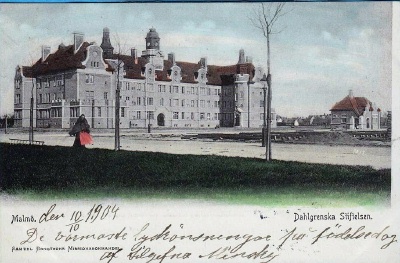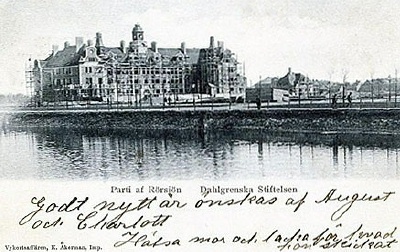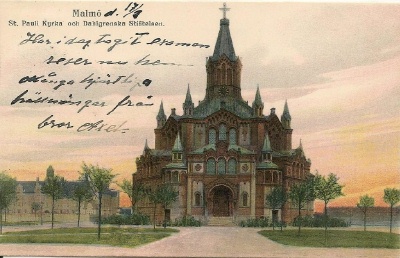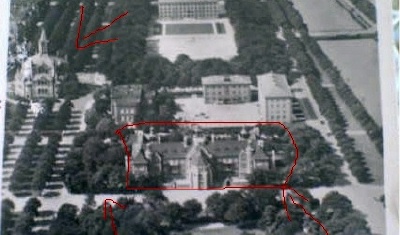|
IDA AND ANNA'S HOME In letter dated February 3, 1947 to Bill and Harriett, Ida listed her return address as Dahlgrenska Stiftelen B2. (In a 1941 letter to Cecil and Anita she listed Andreegaten 2 as her return address which I believe is the same location.) From her letter, she wrote describing her location: "...youngsters have a great time skating on the canal outside our window (our house a big castle) is located in a big park, and very nice..." This place was demolished in 1978 but its history is noted in Wikipedia: "Dahlgrenska Foundation is a charitable foundation in Malmo, best known for his now-demolished castle-like building in the district Rörsjöstaden, where needy people could stay for free.
The building, which
was
designed by architect
Axel
Anderberg
and inaugurated in
1903,
came about
through the
testamentary dispositions
of
the Royal Court Jeweller
Gustaf
Dahlgren
(1815-75).
It
was surrounded by
a plantation
with
a
doorman
building
at the entrance
and consisted of
10
apartments of
two
rooms and a kitchen
for small
families
and 24
apartments,
1 bedroom apartment
for lonely
people.
The
Foundation
was
occupied
"välfrejdad
person,
but not
from the
lower working
class,
which
attained
50 years of
age,
at least 10 years
belonged to
Malmo
society,
beneath
properly
paid
his
dues
and
is not
vulnerable in society,
with preference
for
native
Malmöbo". |
   1904-1907 postcards of Dahlgrenska Stiftelen - Indeed it did look like a castle! |
 Demolition of the Dahlgrenska Stiftelen in 1978 |
|
Canal where Ida observed the ice skaters from her window. Buildings in background likely did not exist in 1947. |
The Dahlgrenska Stiftelen location is now vacant land. |
|
St Pauli Church, built in 1881, is located around the corner from where Ida and Anna lived. Their death records are recorded here while earlier family information was recorded in St Petri and Caroli parishs. |
 Early postcard of St Pauli with the Dahlgrenska Stiftelen in the background to the left |
   Arial view of St Pauli and the Dahlgrenska Stiftelen |
St Pauli from same view as above postcard - except the trees have grown up; |
|
Another view of St Pauli, looking south from the canal. |
|
|
From:
St Peter's Church Website: |
At 105 meters the St Petri steeple was the tallest structure in Malmo until the 1990's |
.jpg) Malmo in 1871 A - Nilsson household, 11b Rostock XXVI, ca 1865-1887 B - Hansson household, 11a Rostock, ca. 1864-1868 C - Dahlgrenska Stiftelen where Ida and Anna lived in the 1940's D - St Pauli Church E - Caroli Church F - St Petri Church G - Town Square - Stortorget H - Cemetey I - Hansson household, Vesterport, ca. 1869-1878+ |
|
Some family records were registered here. |
Stortorget (Great Square) - building is the Townhall (Radhuset) that was initially built in 1547. Behind it is the St Petri steeple. |
The old burial grounds. Cemetery was started in 1820 and at that time it was referred to as the new burial grounds. Likely some of our ancestors were buried there, but if taxes were not paid the plots were not maintained - unclear what might have happened to the bones. |
Most of the grave sites were very well maintained and some had recent burials. |
|
This building is near location of where Carl Alfred lived when he was growing up. Placard reads: "This house was built between 1522-1525 by the coin master and mayor of Malmo." |
NE corner of Block "Grabroden" that Carl Alfred listed as home on his "moving certificate" (left Malmo for America in 1887). Earlier (1868-1878+) the family lived on Block "Vesterport, one block west. These building appeared to be of 1920 vintage. |
|
These houses (near where the Hanssons lived) had signs indicating they were built in the 1840's and may represent the housing that our ancestors lived in. |
Karen strolling down street in my grandfather's childhood neighborhood |
|
|
|
| Malmo archive building where genealogy records are centralized so one doesn't go from parish to parish searching for info. These include microfilm and hard copy records as well as free access to various databases where scanned copies of the original documents can be viewed and copied. There was a large room with a number of microfilm readers and computer monitors that we could use. There were few visitors and the staff was most helpful in searching and reading documents for us. | |
